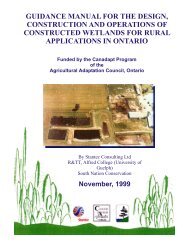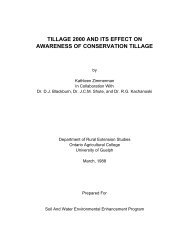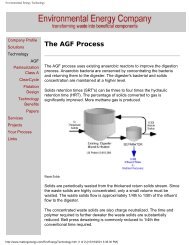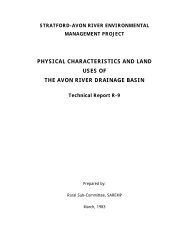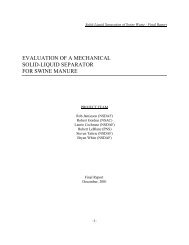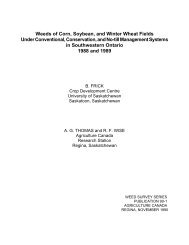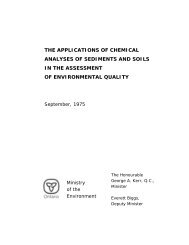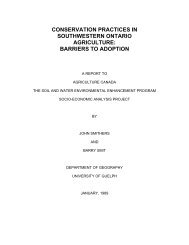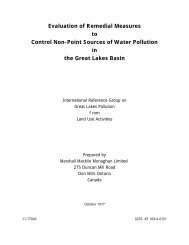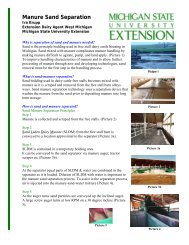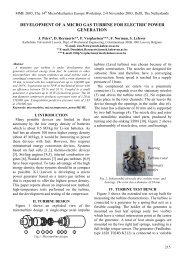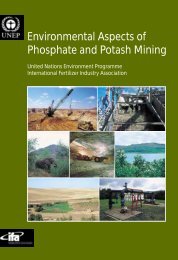demonstration of biogas production using low moisture content
demonstration of biogas production using low moisture content
demonstration of biogas production using low moisture content
You also want an ePaper? Increase the reach of your titles
YUMPU automatically turns print PDFs into web optimized ePapers that Google loves.
Results and Discussion<br />
diffusion through the threads used to seal the cap onto the container. Samples analyzed immediately after<br />
removal from the water had the highest methane <strong>content</strong>s.<br />
Total <strong>biogas</strong> volumes for Experiment 3 were variable within the same <strong>moisture</strong> <strong>content</strong> (Figures 10a-10e and<br />
Table 3). In an experiment comparing <strong>biogas</strong> <strong>production</strong> between dry and fresh dairy manure, Chen et al.<br />
(1988) found that varying levels <strong>of</strong> methane were produced because <strong>of</strong> microbial variations. This is supported<br />
by Hashimoto et al. (1981) who stated that the degree <strong>of</strong> contamination by inorganics also affect ultimate<br />
methane yields (B 0 ). The <strong>biogas</strong> <strong>production</strong> volumes for Experiments 1 and 2 are significantly <strong>low</strong>er than<br />
previously published values for beef cattle manure (Safley et al., 1992). Safley states that B 0 should be<br />
approximately 0.33 m 3 /kg VS. As expected, <strong>production</strong> volumes increased as <strong>moisture</strong> <strong>content</strong> increased, with<br />
minimal <strong>production</strong> be<strong>low</strong> 40% <strong>moisture</strong> <strong>content</strong> for both Experiment 1 and Experiment 2. As shown in Table 1,<br />
there were no statistically significant differences in mean <strong>biogas</strong> <strong>production</strong> rates among the first five <strong>moisture</strong><br />
<strong>content</strong>s, but mean <strong>biogas</strong> <strong>production</strong> rates were significantly higher for the two highest <strong>moisture</strong> <strong>content</strong>s for<br />
Experiment 1.<br />
Field Demonstration Project<br />
The first cell began <strong>biogas</strong> <strong>production</strong> on August 1, 1999, and ceased quickly on October 23, 1999. During the<br />
12 week period, the first cell produced a total <strong>of</strong> about 1,500 m 3 (53,000 ft 3 ) <strong>of</strong> <strong>biogas</strong> with a maximum<br />
methane concentration <strong>of</strong> 52%. This was considerably less than was produced in the laboratory experiment 3,<br />
thus we believe that all <strong>of</strong> the volatile solids have not been expended, and <strong>biogas</strong> <strong>production</strong> should occur<br />
again during the summer 2000 as soon as the temperature is warm enough.<br />
Biogas <strong>production</strong> volumes and methane concentrations are shown in Table 4 and plotted in Figure 11. A<br />
photograph <strong>of</strong> the <strong>biogas</strong> cell when it was full <strong>of</strong> <strong>biogas</strong> is shown in Figure 12.<br />
Shown in Figure 13 is the temperature <strong>of</strong> the manure within cell no. 1 since it was loaded in January, 1999.<br />
Initially the manure temperature was about 25° C (77° F), but temperatures dropped rapidly during the first<br />
month as the manure became anaerobic. Temperatures began rising during the summer months, a result <strong>of</strong><br />
warmer ambient temperatures, and peaked around the first <strong>of</strong> August at 22.4° C (72° F). The manure<br />
temperature dropped be<strong>low</strong> 15° C (59° F) in the middle <strong>of</strong> October and has remained be<strong>low</strong> 15° C until the<br />
present (May, 2000). The pH <strong>of</strong> the manure in cell 1 was tested immediately after cessation <strong>of</strong> <strong>biogas</strong><br />
<strong>production</strong>. The pH <strong>of</strong> the three samples was 7.26, 6.98, and 7.00.<br />
The total volatile solids in cell 1 was 1.55 x 10 7 g. The total volume <strong>of</strong> <strong>biogas</strong> produced in cell 1 was 1.51x 10 6 L<br />
for the 12 weeks <strong>of</strong> <strong>production</strong>, which equates to a <strong>biogas</strong> <strong>production</strong> rate <strong>of</strong> 0.10 L/g VS.<br />
http://www.westbioenergy.org/cattle/results.htm (2 <strong>of</strong> 15) [3/26/2003 8:52:58 AM]



